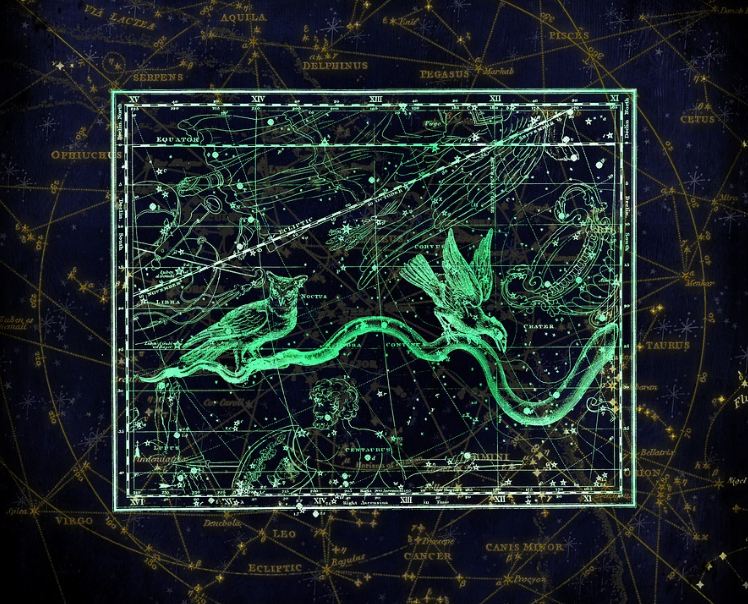Currently, there are 88 constellations scattered through the night sky in both the northern and southern hemispheres. Some of these, especially the greek ones, have been known since ancient times. Here’s a list of the largest constellations in the night sky.
Hydra
Hydra is the largest of all the constellations that take up to 3.2% of the sky, or approximately 1302.8 square degrees. It’s visible near the equator and southern hemisphere during January and February. The Hydra was named after the water snake, and since it’s a long thin constellation, its head lies just to the south of the constellation Cancer. Its tail has a declination of 30°S with an angular distance of 85° between it and the head. Although it’s large, the constellation is a faint one, and its brightest star Alphard is its only star brighter than the third magnitude.
In the Greek myth, Hydra is often identified as a multi-headed creature monster with six or more heads that grew two more for each one severed, but as a constellation, it only has one head.
The constellation contains the Messier objects M48, M68, and M83 and the Caldwell object C59. Some of its well-known neighbors are the constellations Cancer, Canis Major, Centaurus, Leo, Libra, and Virgo.
Virgo
Virgo is the second, next to Hydra, as the largest of the constellations. This constellation takes up 3.1% 1294.4 square degrees of the sky. Virgo lies on the celestial equator and best seen during May. Its brightest star is Spica.
In the Greek myth, Virgo is the daughter of Zeus and Themis and is known as the goddess of justice. She is seen holding the scales of justice, which is represented by Libra.
This constellation contains the Messier objects M49, M58, M59, M60, M61, M84, M86, M87, M89, M90, M104, and the Caldwell object C52. Virgo has the known constellations Hydra, Leo, Libra, Bootes, Coma Berenices, Corvus, Crater, and Serpens Caput as its neighbors.
Ursa Major
Ursa Major or the Big Dipper’ or ‘the Plough’ is the third largest and is one of the most famous and recognizable constellations. It occupies 3.1% or 1279.7 square degrees of the sky.
The constellation is identified as a bear, and its main body is made up of seven stars, and one of them is a second-magnitude star called Alioth. Two of its stars, Merak and Dubhe, are what you call “pointer stars.” These stars form a line that directly points to the north pole star, Polaris. In the Greek myth, the Ursa Major is one of Zeus’ many lovers, Callisto.
The Ursa Major constellation contains the Messier objects: M81, M82, M97, M101, M108, M109. Its neighbors are Leo, Leo Minor, Bootes, Camelopardalis, Canes Venatici, Lynx, Draco, and Coma Berenices.
Cetus
Cetus is the fourth on the list of the largest constellations. It takes up 3% or 1231.4 square degrees of the sky area. The constellation is best seen during November and is located south of the ecliptic.
The constellation has few bright stars despite its size. One is Diphda, its brightest star, and the other, Mira or o-Cet. Mira has a fluctuating brightness of 3-10 magnitude and was the first variable star ever to be discovered.
Cetus is a whale or a sea monster in Greek mythology, dispatched by Poseidon, slain by Perseus. It was sent to destroy Cepheus’s kingdom where Andromeda, also one of the constellations, was to be sacrificed.
Cetus contains the Messier object M77, and the Caldwell objects C51, C56, and C62. The constellation’s neighbors are Aquarius, Aries, Pisces, Taurus, Eridanus, Fornax, and Sculptor.
Hercules
Hercules is the fifth largest constellation and covers 3% or 1225.1 square degrees of the sky. It can be viewed between the +90° and -50° latitudes and best seen during July. Although it’s a large constellation, it only has two brighter stars than the third magnitude. Its most shining star is called Kornephoros.
The constellation gets its name from ‘Hercules,’ the Latin name for Heracles, the Greek hero. The constellation is usually depicted with Hercules’ foot on the dragon Draco’s head, one of the creatures he has slain.
The constellation contains the Messier objects M13 and M92. Hercules’ constellation neighbors are Draco, Lyra, Ophiuchus, Corona Borealis, Aquila, Bootes, Sagitta, Serpens Caput, and Vulpecula.
Except for these five, other notable large constellations that take up at least 2% of the sky area are: Eridanus (2.8%), Pegasus (2.7%), Draco (2.6%), Centaurus (2.6%), Aquarius (2.4%), Ophiuchus (2.3%), Leo (2.3%), Bootes (2.2%), Pisces (2.2%), and Sagittarius (2.1%).
The largest constellations in the sky, in general, are Hydra, Virgo, Ursa Major, Cetus, and Hercules. When divided into two hemispheres, the largest constellations for the northern hemisphere are Ursa Major, Hercules, Pegasus, Draco, and Leo. The largest ones are Hydra, Virgo, Cetus, Eridanus, and Centaurus for the southern hemisphere.


